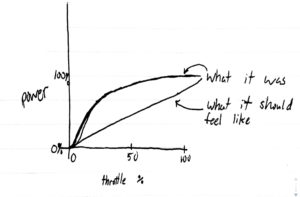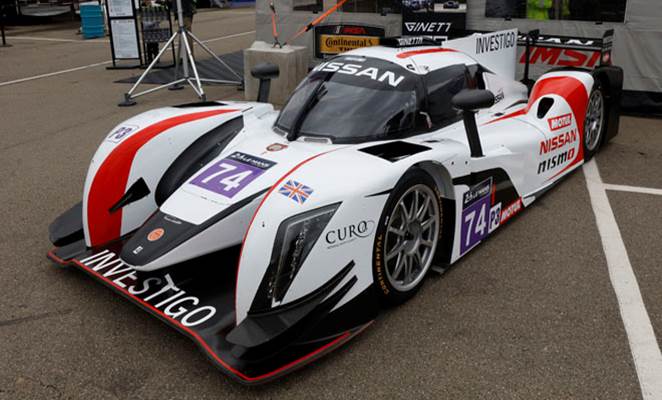LMP3 ON U.S. SOIL
Earlier this week IMSA and Ginetta hosted a track day at Watkins Glen to test the UK-based company’s LMP3. I believe this is the first time an LMP3 has set foot on US soil.
Racer.com wrote a piece about the test, as well as IMSA’s evaluation of whether to bring the LMP3 into its racing sphere. What you may not have read yet is what someone who drove the car thought of it! How did it compare to other prototypes? What was good? What should be changed?
While the powers that be mull the possibilities and challenges, I’ll go on record saying the LMP3 felt like a potential step forward and good replacement of the aging LMPC.
“With a little luck, IMSA would make the LMP3 faster than the LMPC, so that eventually we have something that looks more like the P1/P2 American Le Mans Series days!” - Matt McMurry
To set the stage, drivers were given about 4-6 laps each. Not a lot of time, but enough to get a feel. For perspective, my comparison set was the other machinery I’ve driven these last two years including the Ligier LMP2, Zytek LMP2, Oreca LMPC and the Elan Prototype Lite. Which do you think the Ginetta was most like? If you guessed the Elan Prototype Lite with a touch of Ligier LMP2, you would be correct, at least from the perspective of how it felt to drive.
Granted, I had just 10 minutes in the seat, but it was a strong 10 minutes that produced the fastest lap time of any driver before the lunch break. What made the Ginetta most like the Elan Prototype Lite was how nimble it was at slow speed. It was formula car like to a degree. I could hustle the Ginetta and get it to rotate easily in the slower corners, which is harder in the LMPC and Zytek P2 that reward a smoother style.
I was comfortable in the Ginetta right away, probably because I have more time in the Elan and Ligier, than I do in the Oreca LMPC and Zytek LMP2. By the third lap I felt I understood all of the car’s behavior and needs and was able to begin attacking with confidence. The car was consistent and comfortable and didn’t do anything unusual, which drivers like and want. Because it was most like the Elan Prototype Lites car, I can imagine drivers coming from that series into LMP3 and adapting quickly. Those used to driving an LMPC might have a longer learning curve, because the LMP3 wants you to hustle to go fast, whereas the LMPC does not.

 The lap time difference between the LMP3 and LMPC was about 9 seconds. I think that about 3-4 seconds of the difference would come from improved set up, testing and track time. It’s important to keep in mind that this was a one-day test cycling about 10-15 drivers through the car. It was more about product sampling than ultimate performance. The other 5-6 seconds in gap could come from the improvements or modifications (noted below) to the car or package that could be specified by IMSA. And maybe with a little luck, IMSA would make the LMP3 faster than the LMPC, and then boost the power in its P class, so that we have something that looks more like the P1/P2 American Le Mans Series days!
The lap time difference between the LMP3 and LMPC was about 9 seconds. I think that about 3-4 seconds of the difference would come from improved set up, testing and track time. It’s important to keep in mind that this was a one-day test cycling about 10-15 drivers through the car. It was more about product sampling than ultimate performance. The other 5-6 seconds in gap could come from the improvements or modifications (noted below) to the car or package that could be specified by IMSA. And maybe with a little luck, IMSA would make the LMP3 faster than the LMPC, and then boost the power in its P class, so that we have something that looks more like the P1/P2 American Le Mans Series days!
01. Power Steering
The Ginetta produced a lot of downforce – which is where it was more like the Ligier LMP2 – in high speed, long duration corners because it was causing the power steering to fail. That prevented me and others from carrying more speed because turning the steering as needed wasn’t possible. We race at many high downforce, heavy load places like Mosport, Road America, VIR and Road Atlanta, so this is a must.
02. Throttle Mapping
I drew a diagram showing how the throttle map felt, and how it should feel. When initially applying throttle out of a corner, the engine was too torquey and felt like a bucking bronco. As I got further into the throttle, the power died off and flattened too quickly. I think this is a pretty simple fix as long as the teams have the ability to adjust the ECU, or the spec ECU setting addresses it.
03. Horsepower
This is a must. But we all knew this going in since the engine was restricted to the European Le Mans Series standard of about 425hp. It needs to be closer to 500hp, so the LMP3 functions like the LMPC in the flow of traffic and operate as its own class without co-mingling in other classes. In Europe, the horsepower on the LMP3 is way too low, and consequently lap times are slower than GT cars. Not good.
The topic of brakes came up too, since the Ginetta was equipped with steel rotors. Honestly, I was pleasantly surprised by the performance of the steel brakes. I was braking in similar places to where I was braking with the LMPC during the United SportsCar Championship race on Sunday. We’d have to check data, though, to be certain. Regardless, I think carbon brakes would be an improvement and help the LMP3 to be presented as a modern prototype; at times the LMPC feels too dumbed down, even though it is remarkably capable.
My final thought is that if IMSA decides to let LMP3 race in the same class as the LMPC in 2016 (or beyond), it will be important to make sure proper comparative testing is conducted beforehand so that there aren’t balance of performance issues within the class. It’s not ideal when one type of car in the same class is quicker in the corners and the other on the straights. Drivers are less able to use their skills to make progress and passes. You just get this ebb-and-flow through each sector that prevents action, and worse, the one with the horsepower edge pretty much always wins. It’s easy to hold off competitors with horsepower.
When I think about the many tasks ahead for IMSA, not only in the LMPC/LMP3 class, but also its DP/P2 class, I’m thinking that I have the easier job in driving! From a fan perspective, what would you like to see happen with the LMPC class? Evolve it to LMP3? Let LMPC and LMP3 run together and hope BOP works? Get rid of LMPC/LMP3 altogether and pray enough teams can find budgets that are 2x-3x greater to run in the P class? What say you?

Got something to say?